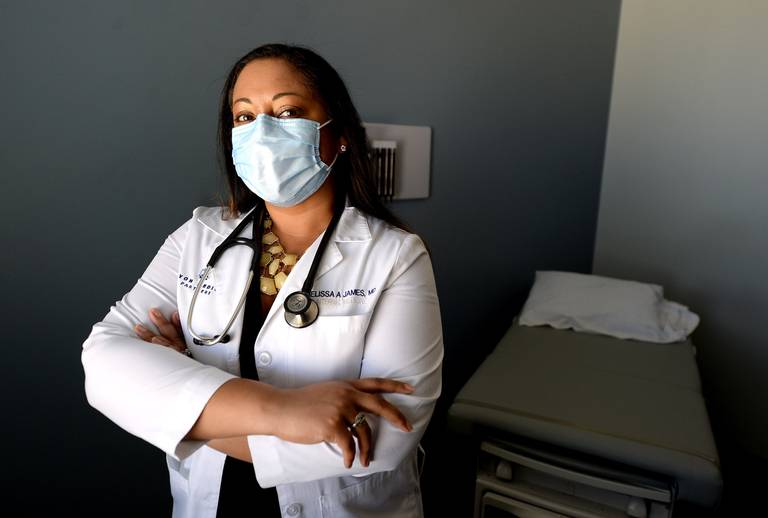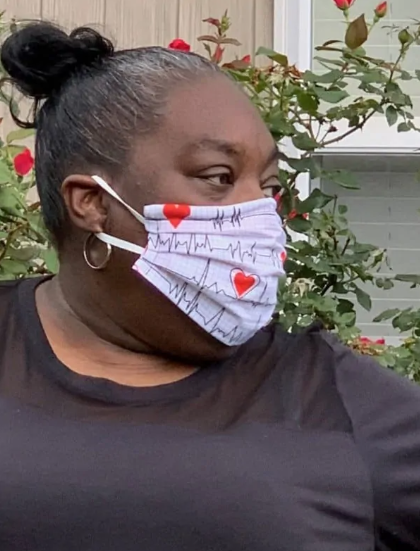
Melissa James can still recall meeting her first coronavirus patient. A woman — probably in her mid-30s — came to the SouthPark office in late February 2020 complaining of lingering respiratory problems she thought might be allergies or a cold she couldn’t shake.
Despite wall-to-wall news accounts of a flu-like virus that had entered the United States from China, the woman never seemed to consider that the virus might be the source of her problem.
James asked a series of screening questions about the patient’s travel, activities and if she’d come in contact with anyone who’d been abroad recently.
“We had this friend who just traveled and he had this cold but it wasn’t a big deal,” the patient told her. “They were doing research in Wuhan.”
Standing close to someone she believed might be infected with a deadly virus, James was momentarily speechless.
“I had a mask on but it wasn’t an N95 mask,” she said. “I remember saying, ‘Ma’am, I don’t want to be rude but I’m about to walk out of this room and change my mask because I’m a little concerned about your exposure.’
“My mind was racing because no matter how much you prepare for something like this, when it’s actually in your face, you’re not ready for it.”
The coronavirus is not James’ first pandemic experience as a health care professional. She was a medical resident in New York during the H1N1 influenza epidemic and a hospitalist at Carolinas HealthCare System (now Atrium) when suspected Ebola patients were treated there in 2014.
“I just remember the decisions that we had to make during Ebola, like deciding who was going to go into the room to see those sick patients,” James said. “I was a newlywed, thinking ‘I haven’t even had kids and I could potentially become deathly ill and die.’ But there was a feeling that the federal leadership took it seriously and was prepared for it.”
Ebola virus disease kills about half of the people it infects, but it was largely contained to West Africa and the doctors who were impacted generally signed on for that battle. Only 11 cases of EVD were diagnosed in the United States and the CDC laid out a clearly defined protocol for handling it.
Things were much different for the coronavirus.
In 2014, the Obama administration assembled the Directorate of Global Health Security and Biodefense team to monitor global health risks and coordinate the federal government’s response. Four years later — and two years before the World Health Organization declared COVID-19 a global pandemic — the Trump administration disbanded it.
While former members of his team were publicly asserting that the administration was not taking the necessary steps to contain the virus, Trump was saying “we pretty much shut it down coming in from China.”
On March 3, 2020, Gov. Roy Cooper announced that North Carolina had its first positive test of the novel coronavirus in Wake County. Eight days later, the same day the NBA canceled the rest of the 2020 season, the first two cases were reported in the Charlotte area.
Even without the pandemic, 2020 was expected to be a challenging year for James and her medical partners. In 2018, she was one of more than 80 doctors who launched a legal battle to contest Atrium’s non-compete clause and form Tryon Medical Partners. Now, just one year into building a medical practice from the ground up, the group had to effectively diagnose and treat patients in the middle of a pandemic when personal protective equipment, testing supplies and good information could be hard to come by.
Fortunately, the practice had testing supplies on hand by the time that first patient came in with her respiratory complaints. Getting results took about 10 days. As James had expected, the woman was positive for COVID-19.
It was the first of many such test results she would deliver to patients in the next year. James estimates 30 to 40 of her patients were diagnosed with the virus each week.
In the meantime, she became the de facto medical adviser for her New York family, calming their fears, answering their questions and debunking rumors and conspiracy theories.
“There was a disparity between the youth and the elders and between the family members who looked at it from a political standpoint, on both sides of the fence,” she said.
THOSE WHO RECOVER
As a primary care doctor, James treats patients of every race, ethnicity and socioeconomic strata. They range in age from 18 to 102. However, it didn’t take long to see the disparities take shape: People of color got very sick, very quickly and had the worst outcomes, she said.
There was the 83-year-old man she’d known for three years, then realized only last year he was illiterate.
Then there was the elderly woman with COVID James called every evening as soon as she arrived home to break the woman’s isolation. One day, James reached her just as she was about to be intubated.
“She was a woman of faith and I’m a woman of faith so we prayed together. I cried when I hung up because I didn’t know if I’d see her again.”
She is still haunted by a virtual visit with a 42-year-old father of three young girls who refused to accept the seriousness of his diagnosis.
“I told him, ‘You need to go to the emergency room. I’m treating you for bronchitis. I have you on inhalers, antibiotics, steroids and you’re still not doing well.’ He said, ‘Dr. James, I’m not going back to the emergency room’ and he ended the call with me.”
James followed up with a message she hoped would move him to act.
“If you don’t go to the ER, I won’t be able to sleep,” she wrote. “I don’t want you to die on my watch.”
He didn’t respond.
The next morning, she learned that he reluctantly had checked into the hospital, where he was treated for blood clots in both lungs. She continued to treat him after his hospital stay. His recovery has been long and slow. She remembers the first time he returned to the office for a visit.
“We were both teary-eyed,” she remembered. “He said, ‘When I was in the hospital I didn’t say bye to my girls, because I didn’t think it was a big deal.’ ”
THE ONES YOU LOSE
While those very ill patients recovered, dozens of others were not so fortunate. Primary care physicians are tasked with signing the death certificate for any patient of record who dies while in the hospital. James believes her signature is on 40 to 50 death certificates for patients who died of COVID-19 in the past year.
The youngest was in his 50s with few underlying health conditions.
“It’s heartbreaking, sad and upsetting, and you never get used to it,” James said. “I get invested in my patients. I take very detailed notes so I remember that you told me you just moved here from Alabama because of your Nana, or whatever. I get nervous having to make the phone call to speak to the next of kin but I always call.”
BEING 'A PART OF THE SOLUTION'
Tryon Medical was one of the first practices in Charlotte to become involved in the COVID vaccine trials. Prior to COVID, the practice had been working with the integrated research organization, Javara, on another project. Javara was contracted to conduct trials for Moderna and asked Tryon if they would participate.
“If we could be a part of the solution and get the world back to a sense of normalcy, absolutely. We will do that!” James said. “And then obviously, you’d have to convince your patients to sign up for it.”
Being a primary care physician affords James the time to develop relationships and build trust with her patients so that when she tells them something, they listen — most of the time. That is particularly important when it comes to not just participating in the vaccine trial but also getting vaccinated.
“For every patient who tells me, 'I’m not getting it,' my first question is ‘why?’ and then I go into, ‘Let me educate you.’ I always just keep it real with them,” she said. “That makes it a little easier 90 percent of the time, but then there’s that 10 percent who say, ‘I won’t do it, I don’t care what you say!’ ”
THE YEAR AHEAD
A year into the pandemic, little in James’ work life has changed. She arrives at the office each morning before 7 a.m. and, depending whether it’s a good day or bad day, returns home between 5 and 7 p.m. After dinner, she spends a few hours on the computer before collapsing in bed.
It’s been a year-and-a-half since she’s seen her extended family. She and her husband, Jason, reserve Saturday for themselves. On those days, they take walks, play Scrabble, watch TV. Unless she’s on call, the computer stays off.
“I just turn off my brain for a second because every other day is COVID,” she said.
The slog has been long and the learning curve incredibly steep, but James views the development of better and more effective COVID-19 treatment protocols as a reason to be hopeful.
“I feel like we are much better equipped,” she said “There’s aftercare now, which wasn’t happening early on. A lot of patients were just being discharged with no follow-up.”
Her optimism is tempered by an underlying resentment and the belief that much of the death and suffering of the past year was unnecessary.
COVID-19 Update: The connection between local and global issues–the Pulitzer Center's long standing mantra–has, sadly, never been more evident. We are uniquely positioned to serve the journalists, news media organizations, schools, and universities we partner with by continuing to advance our core mission: enabling great journalism and education about underreported and systemic issues that resonate now–and continue to have relevance in times ahead. We believe that this is a moment for decisive action. Learn more about the steps we are taking.





